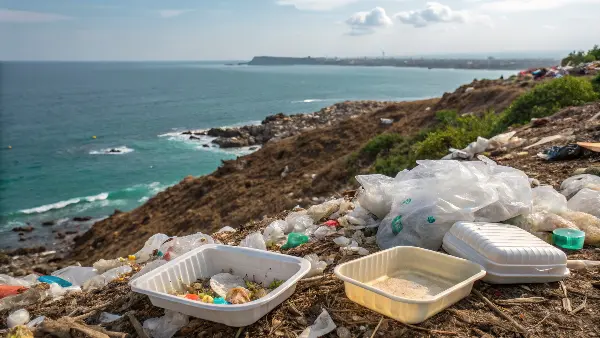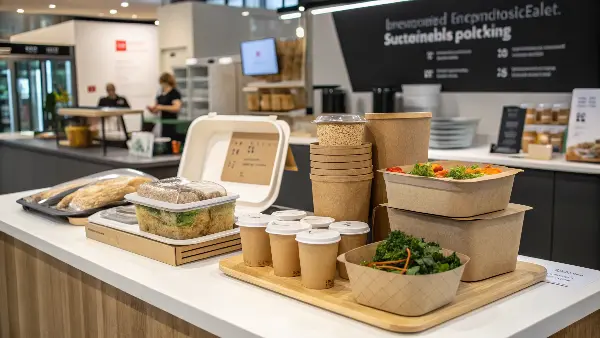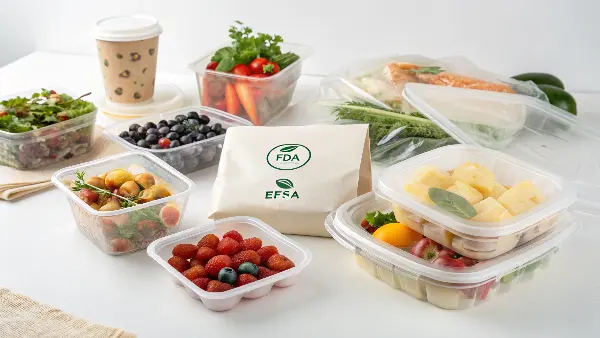Tired of seeing mountains of plastic waste from takeout containers and single-use plates? This pollution harms our planet and brands face pressure to change. Biodegradable tableware offers a vital solution.
Biodegradable tableware is the future because it drastically reduces plastic pollution, uses renewable resources like plants, meets growing consumer demand for sustainable options, and helps businesses comply with stricter environmental regulations worldwide. It’s a shift towards responsible consumption.
This change isn’t just about feeling good; it’s becoming a business necessity. As we at Ecosourcecn work with clients globally, the demand for sustainable alternatives is undeniable. Let’s explore why this trend is accelerating and what it means for the packaging industry.
What is the future of biodegradable packaging?
Wondering where investments in sustainable packaging should go? The landscape is evolving fast, making it hard to predict. Focusing on key trends helps make smarter choices.
The future of biodegradable packaging involves advanced materials beyond just PLA or bagasse, increased focus on certified compostability (home and industrial), better collection infrastructure, stricter global regulations, and integration into a circular economy model emphasizing waste reduction.
!
The journey for biodegradable packaging is moving beyond the initial phase. While materials like PLA (from corn starch) and bagasse (from sugarcane) are now mainstream and vital parts of our offerings at Ecosourcecn, innovation continues. We’re seeing exciting developments that promise even greater sustainability.
Emerging Materials
Researchers and startups are exploring new sources for biodegradable materials:
- Seaweed-based plastics: Offer potential for biodegradability even in marine environments.
- Mycelium (mushroom root): Can be grown into custom shapes for protective packaging, replacing foam.
- Food Waste Valorization: Using agricultural byproducts or food processing waste to create packaging materials.
These are still scaling up, but they point towards a future with diverse, hyper-localized material sources.Infrastructure and Certification
A major hurdle is the end-of-life management. The future depends heavily on improving access to industrial composting facilities globally. Simultaneously, there’s a push for materials certified for home composting, making it easier for consumers. Clear labeling and internationally recognized certifications (like BPI, TUV Austria’s OK compost HOME/INDUSTRIAL) will become even more critical for building trust and ensuring proper disposal. We always guide our clients like Jacky to prioritize certified products.
Integration with Circularity
Biodegradable packaging isn’t a magic bullet if used excessively. The future integrates it within a broader circular economy. This means optimizing packaging design to use minimal material, exploring reusable packaging systems alongside single-use compostables, and ensuring materials genuinely return to the soil as nutrients, completing the cycle.
Why is it important to use biodegradable materials for packaging?
Seeing the endless stream of plastic packaging clogging landfills and oceans? This reliance on fossil fuels has severe consequences. Switching to biodegradable options is a crucial step towards change.
Using biodegradable materials is important because it directly tackles plastic pollution, lessens our dependence on finite fossil fuels, often results in a lower carbon footprint during production, meets powerful consumer demand for greener choices, and helps businesses stay ahead of environmental regulations.

The sheer scale of conventional plastic production and disposal presents enormous environmental challenges. Shifting to biodegradable alternatives, particularly those derived from renewable resources, offers significant advantages that we emphasize daily in our work at Ecosourcecn.
Reducing Landfill Burden
Conventional plastics can persist in the environment for hundreds or even thousands of years. Biodegradable and especially compostable materials are designed to break down much faster under specific conditions. When properly managed (ideally through composting), they divert significant amounts of waste from landfills, reducing the pressure on these sites and minimizing long-term pollution. I remember visiting a landfill site early in my career; the sheer volume of plastic was staggering and reinforced my commitment to finding alternatives.
Decreasing Fossil Fuel Dependence
Most traditional plastics (like PET, PP, PS) are derived from petroleum or natural gas – finite resources. Their extraction and processing are energy-intensive and contribute to greenhouse gas emissions. Biodegradable materials, especially plant-based ones like PLA and bagasse, utilize renewable resources that can be regrown, decoupling packaging from fossil fuel extraction.
Lowering Carbon Footprint
While life cycle assessments can be complex, the production of many plant-based biodegradable materials generally requires less energy and results in fewer greenhouse gas emissions compared to their petroleum-based counterparts. This helps mitigate climate change impacts.
Meeting Market Demands and Regulations
Consumers, especially younger generations, are increasingly aware of environmental issues and actively seek brands that demonstrate responsibility. Using biodegradable packaging enhances brand image and loyalty. Furthermore, governments worldwide are implementing bans or taxes on single-use plastics, making biodegradable alternatives not just a choice but often a necessity for compliance. Helping businesses navigate these regulations is a core part of our service.
What is the future of food packaging?
Struggling to balance food safety, shelf life, cost, and sustainability in packaging? It’s a complex act. The future demands innovation across all these fronts simultaneously.
The future of food packaging centers on sustainability: Expect more biodegradable/compostable options, a surge in recycled content, minimalist designs, smart features like freshness tracking, and a major shift towards circular models including reuse and refill systems.

Food packaging faces unique challenges. It needs to protect the product, ensure safety, provide information, and often, market the item effectively. Historically, plastic has excelled here, but its environmental cost is too high. The future involves a multi-pronged approach where sustainability is not an afterthought but a core requirement.
The Rise of Sustainable Materials
Biodegradable and compostable materials like PLA, CPLA (for heat resistance), and bagasse will continue to grow, especially in food service and for short-shelf-life products. Alongside these, we’ll see:
- Increased Recycled Content: Using post-consumer recycled (PCR) materials (like rPET for bottles or trays) where food safety regulations allow.
- Paper-Based Solutions: Development of advanced paper coatings and treatments to provide barriers needed for food, making paper viable for more applications.
Minimalism and Efficiency
"Less is more" will be a guiding principle. This means reducing the amount of packaging used overall (right-sizing), eliminating unnecessary layers, and choosing lightweight materials. Minimalist design also often conveys a sense of naturalness and sustainability.
Reuse and Refill Models
For certain products, single-use packaging might be replaced entirely by reusable containers within closed-loop or deposit-return systems. We’re seeing this gain traction in grocery (bulk bins, reusable containers for deli items) and even takeout.
Smart Packaging
Technology will play a role. Intelligent packaging can monitor freshness or temperature, reducing food waste. Active packaging might incorporate elements to extend shelf life. While potentially adding complexity, these can contribute to overall sustainability by preventing food loss. As a supplier, we at Ecosourcecn are watching these tech trends closely to see how they integrate with sustainable materials.
Can biodegradable plastic be used for food packaging?
Worried if biodegradable plastics are safe and effective for contact with food? Ensuring safety is paramount. Thankfully, many options meet strict standards for food applications.
Yes, specific biodegradable plastics like PLA (polylactic acid) are approved by regulatory bodies (like the FDA and EFSA) and are widely used for food packaging. They must meet rigorous safety tests to ensure they don’t leach harmful substances into food.

The term "biodegradable plastic" covers a range of materials, but when it comes to food contact, safety is non-negotiable. Not every plastic labeled "biodegradable" is suitable or legally permitted for packaging food. However, several key materials have established track records and necessary approvals.
Focus on Food-Grade Materials
- PLA (Polylactic Acid): This is the most common food-grade biodegradable plastic, derived from plant starches like corn or sugarcane. It’s used for cold cups, salad containers, deli pots, cutlery, and transparent windows on boxes. Standard PLA has low heat resistance.
- CPLA (Crystallized PLA): A heat-resistant variant of PLA, suitable for hot food containers, lids, and cutlery (often up to 85°C/185°F).
- Other Bioplastics: Materials like PHA (Polyhydroxyalkanoates) are also being developed for food packaging, sometimes offering different properties like better flexibility or biodegradability in different environments.
Safety Standards and Regulations
Materials intended for food contact must comply with strict regulations, such as those set by the U.S. Food and Drug Administration (FDA) or the European Food Safety Authority (EFSA). These regulations ensure that no harmful chemicals migrate from the packaging into the food at levels that could pose a health risk. Reputable suppliers like Ecosourcecn ensure their food-contact products meet these standards (e.g., FDA 21 CFR, EU Regulation 10/2011). I always remind clients like Jacky to specifically request documentation confirming food-contact compliance for any packaging they source.
Functional Considerations
Beyond safety, the chosen biodegradable plastic must function correctly. Key factors include:
- Barrier Properties: Resistance to moisture, oxygen, and oils to protect food quality.
- Temperature Resistance: suitability for hot, cold, or frozen foods (PLA vs. CPLA).
- Clarity and Appearance: Important for product visibility.
- Durability: Must withstand handling and transport.
Matching the right material to the specific food application is crucial for success.Conclusion
Biodegradable tableware isn’t just a trend; it’s a necessary evolution in food packaging, driven by environmental needs, consumer choice, and regulations. Embracing it is key for a sustainable future.


